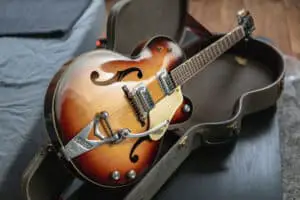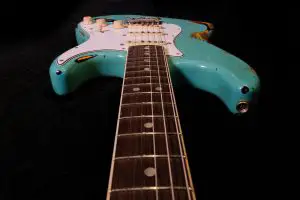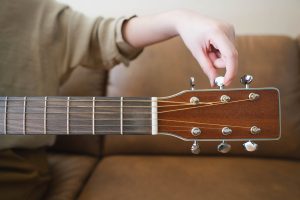
A perfect octave is a series of twelve notes that starts and ends at the same keynote, but the interval notes have a double frequency difference between them. In other words, the ending note would have two times the frequency of the beginning one.
So, how many of these octaves can you play on a guitar?
On a standard guitar with 22 frets and six strings, there are nearly four octaves that you can play. It means that there are almost 49 notes on a guitar which is quite a versatile number for any kind of singing or performance matchup.
Remember that these numbers may change slightly depending upon the number of frets on your guitar or even your guitar type.
Keep reading to find out all about these octaves in detail.
Finding the Octaves
As a beginner, you might face difficulty finding the octaves’ exact positioning. That is why most guitarists will encourage you to learn about octaves, even before remembering the notes.
Recognizing your octaves can provide you with many advantages:
- You will know your guitar’s fretboard by heart.
- It will help you understand all the scales and notes easily.
- You will improvise a lot faster.
- You’ll be able to pull off your own solo performances because the octaves will help you match your vocals with the guitar.
So, learning the octaves is really important for your musical journey.
There are many different guitar types, each having a different number of strings and frets. A guitar with 24 frets will have 4 octaves in total. However, if your guitar has 22 frets, the fourth octave will not be complete, and you’ll get precisely 3⅚ octaves.
There are many different ways to identify the octaves on your guitar. However, below are some of the easiest ways to locate the octaves on a guitar.
Octaves on the Same String
Start playing from the open E string, which is the 6th string and the thickest one. Pluck the string without touching any fret. That will be your E note of the first octave.
Now count all the way up to the 12th fret staying on the exact string. Place your finger below that fret and pluck the string again. That here is your E note again, but one octave higher.
You can repeat this process for all the open strings. Just find the 12th fret above that same string, and you’ll hit a note one octave higher than the original one.
Octaves on Different Strings
Assuming that your guitar is tuned regularly, the 1st and 6th strings will both produce an E note. However, the E note from the 1st string will be two octaves higher than the E note from the 6th string.
In the same way, strumming the 3rd fret from both the 1st and 6th strings will produce a G note, and the note from the 1st string will be 2 octaves higher.
Finding the notes one octave high on the 5th and 6th strings is also easy. You just move up two frets and then down by two strings to get to the same note, one octave higher.
3rd fret on the 5th string brings you a C note. Move to the 1st fret (which is two frets up) and the 2nd string (two strings below). That is also your C note but one octave higher.
You can apply the same trick for the 3rd and 4th strings too. However, instead of moving up two frets, you’ll have to move up three frets to get one octave higher note.
4th fret on the 3rd string brings you a B note. Move over to the 6th string (two strings below) and the 7th fret (three frets above). That is your B note, too, but one octave higher.
If you want to find the lower octaves on the 1st and 2nd strings, use the trick you used to go up an octave on the 3rd and 4th strings.
Fretting the 1st string on the 3rd fret gets you a G note. Moving to the 4th string (two strings down) will get you the same G but one octave lower.
Inference
From here, you can practice yourself if you memorize these basic patterns. You will feel a lot more confident with your instrument, and you’ll start enjoying your guitar sessions.
Learning these octave patterns will also help you understand all the notes on your fretboard. It might seem difficult at first, but practice makes perfect. Once you master these octaves, learning new chords and becoming an improviser will feel much more effortless.









